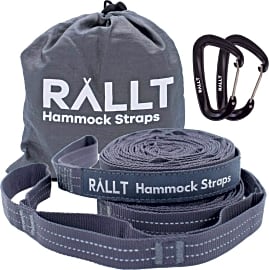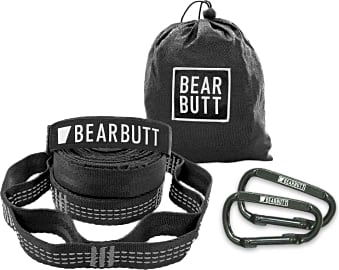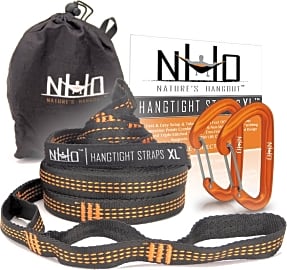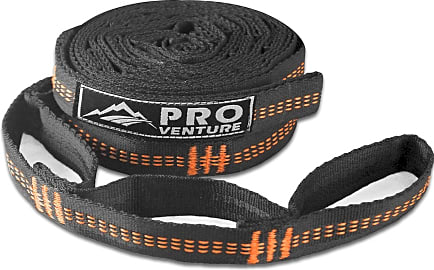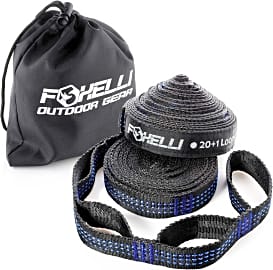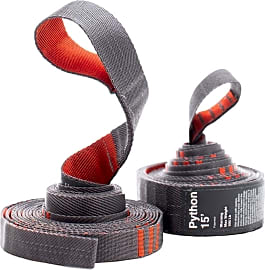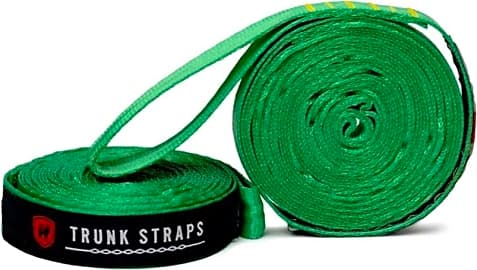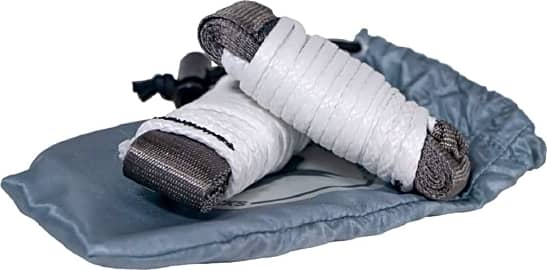The 10 Best Hammock Straps

This wiki has been updated 37 times since it was first published in January of 2017. Before you're ready to kick back in your new leisure or backpacking hammock, you're going to need to invest in some strong, durable straps. These suspension systems are rated to hold hundreds of pounds and can be firmly attached to trees or other sturdy supports in a few simple steps. They'll give you peace of mind, so you can relax, whether you're at home or in the woods. When users buy our independently chosen editorial recommendations, we may earn commissions to help fund the Wiki.
Editor's Notes
March 08, 2021:
We replaced the ENO Helios System with the ENO Atlas, another model from the same brand that offers a weight capacity that's 100lbs higher than the Helios.
The Byer of Maine MicroRopes were removed because they weren't compatible with as wide of a range of hammocks as others. Since this was the smallest option on the list, we replaced it with another tiny model: the Hummingbird Ultralight. These small yet sturdy straps use the whoopie sling system, rather than a daisy chain, so they're highly adjustable, even after the hammock has been hung, but they hold firm when weight is applied. With their small size and low weight, they're a good choice for backpackers.
We replaced the Nature's Hangout HangTight Suspension with the Nature's Hangout HangTight XL. These are similar to the other model, but 14 feet long each instead of the standard 10. If you like to set up in an area where you have a hard time finding trees that are close together, this extra length can be extremely useful.
Also new to the list, the Grand Trunk Suspension is a fun option for those who are looking for something to match a colorful hammock, or who don't want their straps to get mixed up with their camping companions'. They come in several colors, from black to orange to teal.
When setting up a hammock, it's important to be aware of your surroundings. First off, you need to be sure that the trees, poles, or other supports you're hooking up to are stable. You also need to be aware of local laws and rules, as there are places where you can get ticketed for setting up a hammock. Finally, you need to be considerate of those around you. Make sure that you aren't blocking a path or trail with your hammock, especially in areas that are frequented by mountain bikers.
September 19, 2019:
We have looked for a wide selection to fit most hammocks, but due to availability issues, we have removed the Chill Gorilla XL at this time. We still like options from popular manufacturers Eagles Nest Outfitters and Rallt, however, thanks to their reliability that is reasonably priced, considering the quality. For ultralight backpackers, we elected to add the Kammok Python 10 UL. They’re a bit pricier than options of the same length, but they feature lightweight but rugged materials that save you a few ounces without sacrificing strength. And for casual, occasional users who don’t need serious (read: expensive) gear, we kept the Pro Venture Adjustable. They are not as slim and trim as some, but they’re fine for car camping and the like.
Special Honors
Dutchware Kevlar 3.3 Friction, heat, and water are no match for the Dutchware Kevlar 3.3, and they’re surprisingly affordable given their strength and high-quality construction. They can’t withstand ongoing exposure to UV light, however, so they shouldn’t be used for permanent suspension in direct sunlight. dutchwaregear.com
Why Hammock Straps?
It won’t stress bark the same way that rope does, and the thickness helps keep it in place better.
Ahhhhh — there’s nothing like gently swinging in a hammock on a lazy afternoon, sipping a cool beverage as the wind stirs the leaves overhead. Whether you’re resting up during a hike, taking a nature break in your own backyard, or unwinding in your business hammock after a long day of pushing to get the reactor online, a hammock is one of the most comfortable and relaxing ways to recharge or daydream. But if you’re like many people, you might not be sure how to secure your gear properly, or even what it is you need to hang a hammock.
Actually, your hammock hanging method is a good place to start. You could use hardware that screws into a hard surface, either a wall or a tree, although the problem with this method is that it harms trees, and after you remove the hardware, you’re left with holes. Another way to hang a hammock is a stand, but most aren’t portable, and for many, a stand makes getting in and out of a hammock more difficult. You can also learn to tie special knots that allow you to use ordinary rope, but this is again a damage risk: rope cuts into a tree’s bark, potentially damaging it. This is why, out of all the methods for hanging a hammock, the hammock strap is arguably the best.
A hammock strap is typically made from high-strength webbing, usually polyester or some other durable material, that is thicker than rope. It won’t stress bark the same way that rope does, and the thickness helps keep it in place better. You’ll also see that most hammock straps have loops along one end, which lets you easily adjust the hammock’s hanging curve. And with no drilling or knots to worry about, you’ll be hanging much more quickly. Then, when you’re done, you can take everything down in a matter of minutes and head off into the sunset, leaving only footprints behind.
It must be said, however, that in one instance, you cannot use hammock straps — when you want to a hang a hammock between two walls. You need something sturdy to wrap the straps around, so a flat surface just won’t cut it. But because you can hang hammock straps from most solid vertical posts or poles, there are generally great options. Even square posts will hold up a good pair of hammock straps.
Hang Your Hammock For Comfort
Once you’ve got your hammock straps in hand, you need to know how to use them with your gathered end hammock. Don’t worry, because this couldn’t be simpler. For the majority of hammock straps, the end that goes around the tree (or post) generally has one loop; wrap it around, pull the strap through, then cinch it against the tree. Next, attach the end of the hammock to one of the loops on the other end. Many hammock straps come with carabiners or S-hooks for this step, but some do not, so you may need to provide your own. Repeat with the second tree, and voilà, the hammock is hung. Having trouble? Read on for a few tips.
Most experts suggest that you look for trees that are at least six to eight inches in diameter.
One problem those new to hammock hanging have is determining how far apart the trees should be. You’ll probably need somewhere between 10 and 15 feet of distance; ideally, you should hang your hammock in a space that’s around 2 feet longer than its length. You don’t need to carry a measuring tape around with you to figure this out, as your results will be fine if you count the distance with your feet by walking heel to toe.
As for height, higher is not always better. To begin with, if the hammock is much higher than chair height, you’re going to have trouble getting in and out of it. Second, you want the hang angle, or the angle between the hammock strap and the tree, to be about 30 degrees, giving you a nice, deep curve. If you try to hang the hammock high and at a right angle to the trees, you will probably not find your bed too relaxing. Of course, you also don’t want the thing so low that you’ll touch the ground when you get in it. Most hammock straps let you quickly adjust and re-adjust so you change the angle without having to select new trees.
Once the hammock is hung, try laying in it diagonally instead of in a perfectly straight line between the trees. Doing so helps keep the hammock spread open and will prevent you from feeling claustrophobic.
Finally, remember that you’ll always need to choose trees or posts that are sturdy. Most experts suggest that you look for trees that are at least six to eight inches in diameter. And if your hammock straps come with instructions specifying any special restrictions, do follow the directions, and pay attention to all weight limits.
A Brief History Of The Hammock
Few things capture the spirit of summertime like a hammock — the symbol of relaxation and sunny days — but the hammock was not created merely for fun. The indigenous peoples of Central and South America rather used hammocks for safe sleeping. Lifted from the ground, they were less likely to be stung or bit by annoying or dangerous creatures and bugs in the nighttime. These early hammocks were originally crafted from tree bark but came to be woven from sisal fiber.
Christopher Columbus brought the hammock back with him to Europe, where sailors embraced the design.
Christopher Columbus brought the hammock back with him to Europe, where sailors embraced the design. Hammocks not only saved space but also kept sailors from having to sleep on hard decks or from rolling out of their bunks on rough seas. Even now, when modern ships offer far greater comfort, some sailors prefer to stick with the tried-and-true hammock.
Today, the hammock is popular across the world, from the Latin American jungles of its origin to the wilds of Canada and beyond. There are hammock tents, two-person models, decorative crocheted versions, those that use mosquito netting, and much, much more. With the right hammock and pair of straps, you can sleep in comfort in all kinds of places, making the humble hammock an invention that keeps on giving.


